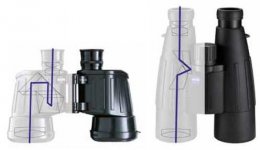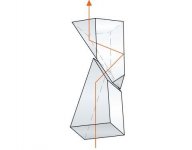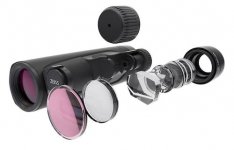Prisms are not only responsible for the correct orientation of the image, they play an important and decisive role in the shape of the housing and image quality of binoculars. Two systems are primarily used today:
Binoculars with Porro prisms are relatively wide with the objective lenses farther apart than the eyepieces. Binoculars with roof prisms are slimmer and more compact. Almost all high quality, state-of- the-art binoculars today use roof prisms.

Left: Beam path in a pair of binoculars with Porro prism system.
Right: Beam path in a pair of binoculars with a roof prism system.
Roof prism systems are so-called because one of the prisms has a surface that consists of a sharply-pointed ridge and so looks rather like the roof of a house. Using both sides of this roof as reflective surfaces makes this system very compact. The accuracy of these two plane surfaces, and the 90° angle between them is, therefore, extremely vital. This especially applies to the roof edge, which must be perfectly sharp as any rounding results in stray light and reflections. Running a finger over the prism makes it unusable.
To achieve the high image quality required, a special coating must be applied to both roof surfaces. This so called “phase-correction” coating, introduced by Carl Zeiss at the end of the 1980s, prevents wave-optical effects (phase shifting) that would otherwise result in a reduction of resolution and contrast. All ZEISS roof prisms are treated with this P coating today.
Roof prisms are usually used in two versions: the Schmidt-Pechan design is the smaller of the two and allows shorter designs, but has one surface that cannot deliver total internal reflection and so requires a mirror coating. Coatings like this can absorb some light but have been much improved in recent years. However, if the priority is maximum image brightness, then the Abbe-König design is preferred.
The Abbe–Koenig system is more expensive to produce and somewhat longer, but does not require a mirrored surface, and so results in brighter images. Therefore, all ZEISS twilight-capable binoculars of include Abbe-König systems which is unique among premium binoculars.
The more compact Schmidt-Pechan system offers more packaging options and so have helped to create the unique balance and ergonomics of Victory SF. As mentioned already, SP prisms require one surface to have a mirror coating applied and for this purpose a special dielectric coating has been developed, consisting of more than 70 layers and applied in a vacuum. It replaces the older, loss- prone silver coatings and comes close to matching the high transmission properties of the Abbe-König prisms.

The Schmidt-Pechan prism is very compact. However, it requires a reflective layer. This means a loss of light.
Unlike roof prisms, Porro prisms are easier to manufacture as they do not have a ‘roof’ edge and enable a very good transmission. Because of their design, binoculars using Porro prisms are difficult to design using internal focusing. If the binoculars focus by moving the eyepieces, as is commonly the case, they are difficult to make both waterproof and to have a comfortable focusing action.
Binoculars with Porro prisms are relatively wide with the objective lenses farther apart than the eyepieces. Binoculars with roof prisms are slimmer and more compact. Almost all high quality, state-of- the-art binoculars today use roof prisms.

Left: Beam path in a pair of binoculars with Porro prism system.
Right: Beam path in a pair of binoculars with a roof prism system.
Roof prism systems are so-called because one of the prisms has a surface that consists of a sharply-pointed ridge and so looks rather like the roof of a house. Using both sides of this roof as reflective surfaces makes this system very compact. The accuracy of these two plane surfaces, and the 90° angle between them is, therefore, extremely vital. This especially applies to the roof edge, which must be perfectly sharp as any rounding results in stray light and reflections. Running a finger over the prism makes it unusable.
To achieve the high image quality required, a special coating must be applied to both roof surfaces. This so called “phase-correction” coating, introduced by Carl Zeiss at the end of the 1980s, prevents wave-optical effects (phase shifting) that would otherwise result in a reduction of resolution and contrast. All ZEISS roof prisms are treated with this P coating today.
Roof prisms are usually used in two versions: the Schmidt-Pechan design is the smaller of the two and allows shorter designs, but has one surface that cannot deliver total internal reflection and so requires a mirror coating. Coatings like this can absorb some light but have been much improved in recent years. However, if the priority is maximum image brightness, then the Abbe-König design is preferred.
The Abbe–Koenig system is more expensive to produce and somewhat longer, but does not require a mirrored surface, and so results in brighter images. Therefore, all ZEISS twilight-capable binoculars of include Abbe-König systems which is unique among premium binoculars.
The more compact Schmidt-Pechan system offers more packaging options and so have helped to create the unique balance and ergonomics of Victory SF. As mentioned already, SP prisms require one surface to have a mirror coating applied and for this purpose a special dielectric coating has been developed, consisting of more than 70 layers and applied in a vacuum. It replaces the older, loss- prone silver coatings and comes close to matching the high transmission properties of the Abbe-König prisms.

The Schmidt-Pechan prism is very compact. However, it requires a reflective layer. This means a loss of light.
Unlike roof prisms, Porro prisms are easier to manufacture as they do not have a ‘roof’ edge and enable a very good transmission. Because of their design, binoculars using Porro prisms are difficult to design using internal focusing. If the binoculars focus by moving the eyepieces, as is commonly the case, they are difficult to make both waterproof and to have a comfortable focusing action.






